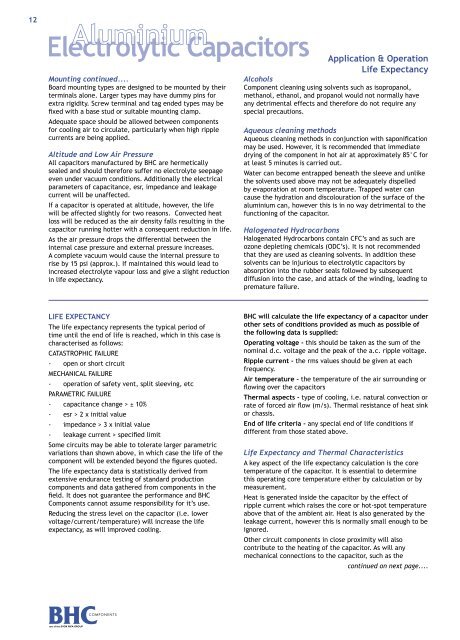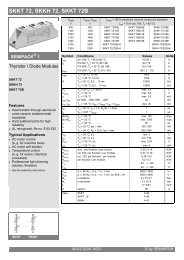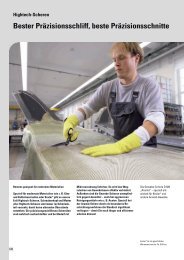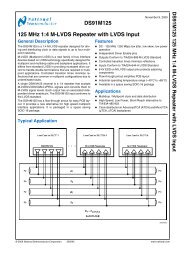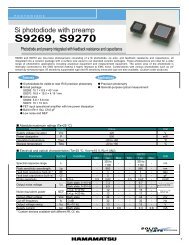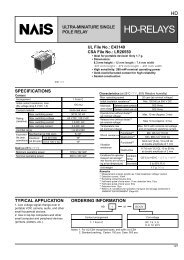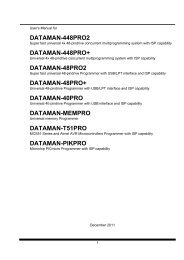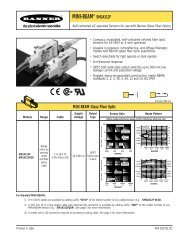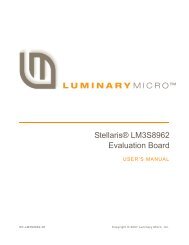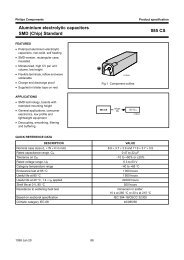Technical Data Sheet - Octopart
Technical Data Sheet - Octopart
Technical Data Sheet - Octopart
Create successful ePaper yourself
Turn your PDF publications into a flip-book with our unique Google optimized e-Paper software.
12<br />
Mounting continued....<br />
Board mounting types are designed to be mounted by their<br />
terminals alone. Larger types may have dummy pins for<br />
extra rigidity. Screw terminal and tag ended types may be<br />
fixed with a base stud or suitable mounting clamp.<br />
Adequate space should be allowed between components<br />
for cooling air to circulate, particularly when high ripple<br />
currents are being applied.<br />
Altitude and Low Air Pressure<br />
All capacitors manufactured by BHC are hermetically<br />
sealed and should therefore suffer no electrolyte seepage<br />
even under vacuum conditions. Additionally the electrical<br />
parameters of capacitance, esr, impedance and leakage<br />
current will be unaffected.<br />
If a capacitor is operated at altitude, however, the life<br />
will be affected slightly for two reasons. Convected heat<br />
loss will be reduced as the air density falls resulting in the<br />
capacitor running hotter with a consequent reduction in life.<br />
As the air pressure drops the differential between the<br />
internal case pressure and external pressure increases.<br />
A complete vacuum would cause the internal pressure to<br />
rise by 15 psi (approx.). If maintained this would lead to<br />
increased electrolyte vapour loss and give a slight reduction<br />
in life expectancy.<br />
LIFE EXPECTANCY<br />
The life expectancy represents the typical period of<br />
time until the end of life is reached, which in this case is<br />
characterised as follows:<br />
CATASTROPHIC FAILURE<br />
- open or short circuit<br />
MECHANICAL FAILURE<br />
- operation of safety vent, split sleeving, etc<br />
PARAMETRIC FAILURE<br />
- capacitance change > ± 10%<br />
- esr > 2 x initial value<br />
- impedance > 3 x initial value<br />
- leakage current > specified limit<br />
Some circuits may be able to tolerate larger parametric<br />
variations than shown above, in which case the life of the<br />
component will be extended beyond the figures quoted.<br />
The life expectancy data is statistically derived from<br />
extensive endurance testing of standard production<br />
components and data gathered from components in the<br />
field. It does not guarantee the performance and BHC<br />
Components cannot assume responsibility for it’s use.<br />
Reducing the stress level on the capacitor (i.e. lower<br />
voltage/current/temperature) will increase the life<br />
expectancy, as will improved cooling.<br />
Application & Operation<br />
Life Expectancy<br />
Alcohols<br />
Component cleaning using solvents such as isopropanol,<br />
methanol, ethanol, and propanol would not normally have<br />
any detrimental effects and therefore do not require any<br />
special precautions.<br />
Aqueous cleaning methods<br />
Aqueous cleaning methods in conjunction with saponification<br />
may be used. However, it is recommended that immediate<br />
drying of the component in hot air at approximately 85°C for<br />
at least 5 minutes is carried out.<br />
Water can become entrapped beneath the sleeve and unlike<br />
the solvents used above may not be adequately dispelled<br />
by evaporation at room temperature. Trapped water can<br />
cause the hydration and discolouration of the surface of the<br />
aluminium can, however this is in no way detrimental to the<br />
functioning of the capacitor.<br />
Halogenated Hydrocarbons<br />
Halogenated Hydrocarbons contain CFC’s and as such are<br />
ozone depleting chemicals (ODC’s). It is not recommended<br />
that they are used as cleaning solvents. In addition these<br />
solvents can be injurious to electrolytic capacitors by<br />
absorption into the rubber seals followed by subsequent<br />
diffusion into the case, and attack of the winding, leading to<br />
premature failure.<br />
BHC will calculate the life expectancy of a capacitor under<br />
other sets of conditions provided as much as possible of<br />
the following data is supplied:<br />
Operating voltage - this should be taken as the sum of the<br />
nominal d.c. voltage and the peak of the a.c. ripple voltage.<br />
Ripple current - the rms values should be given at each<br />
frequency.<br />
Air temperature - the temperature of the air surrounding or<br />
flowing over the capacitors<br />
Thermal aspects - type of cooling, i.e. natural convection or<br />
rate of forced air flow (m/s). Thermal resistance of heat sink<br />
or chassis.<br />
End of life criteria - any special end of life conditions if<br />
different from those stated above.<br />
Life Expectancy and Thermal Characteristics<br />
A key aspect of the life expectancy calculation is the core<br />
temperature of the capacitor. It is essential to determine<br />
this operating core temperature either by calculation or by<br />
measurement.<br />
Heat is generated inside the capacitor by the effect of<br />
ripple current which raises the core or hot-spot temperature<br />
above that of the ambient air. Heat is also generated by the<br />
leakage current, however this is normally small enough to be<br />
ignored.<br />
Other circuit components in close proximity will also<br />
contribute to the heating of the capacitor. As will any<br />
mechanical connections to the capacitor, such as the<br />
continued on next page....


